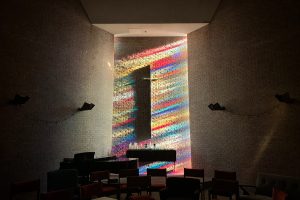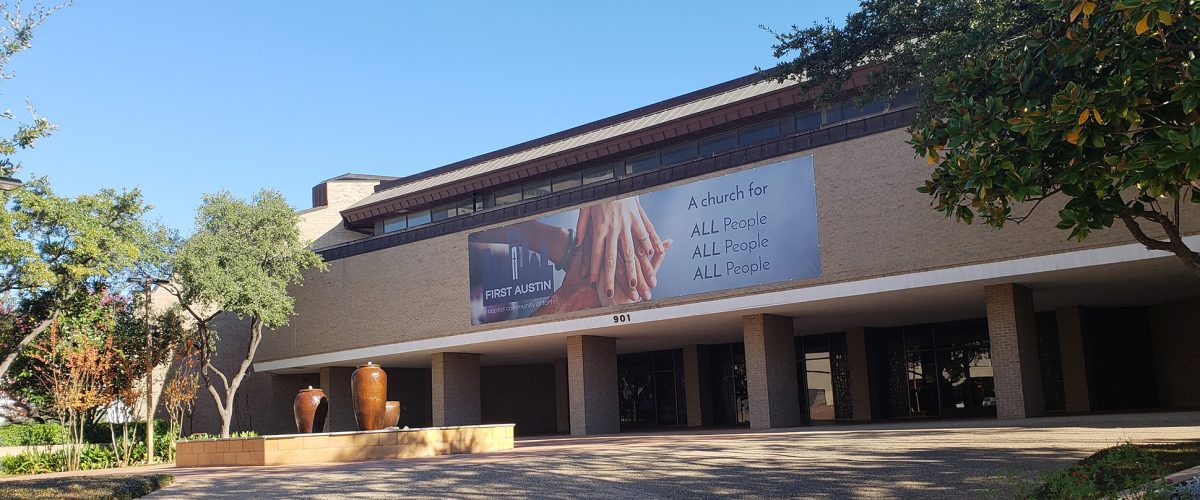It has taken a pandemic and roughly two years of discussion, but First Baptist Church in Austin, Texas, is beginning to see how it might downsize without having to abandon its campus, while simultaneously expanding its downtown ministries.
Senior Pastor Griff Martin said events of the past few years gave the historic congregation time to see it needs to be proactive in addressing the facilities, financial and attendance challenges common to many U.S. congregations, especially those located in downtowns.

Griff Martin, pastor of First Baptist Church, Austin, speaks to about 250 people at a “#YallMeansAll” rally organized by the interfaith group Texas Impact in 2017. (Photo/Facebook)
First Baptist’s multistory facility has been located on a block and a half of property at the corner of Trinity and Ninth streets since 1970. The church, which is affiliated with the Cooperative Baptist Fellowship, also boasts a 150-seat theater used weekly by area theater groups.
The building was considered contemporary and innovative when it was built 54 years ago.
First Baptist has a rich history in the capital city of Texas, actually meeting in the Capitol building from 1847 to 1855. In the church’s first permanent building, also located downtown, Woman’s Missionary Union of Texas was organized in 1880.
On March 12, 1916, George W. Truett preached the dedication sermon for a new building at 10th and Colorado. Even at that time, First Baptist Church made the first of several decisions to remain a downtown church rather than moving to the suburbs.
That’s the same conversation the church has re-engaged lately about its current facility, where in 1969 the cornerstone was laid atop the cornerstone of the previous church building on that same site.

The sanctuary of First Baptist Austin.
“Two years of conversation provided the space to be more creative and to stay out of crisis thinking,” Martin said. “COVID gave us the opportunity to pause and see what was going on. It’s no surprise that a progressive Baptist church built for 1,000 is not going to have that many in worship on Sundays.”
The church also used the time to drill into its ministry and worship priorities and discuss how it can best serve its members and the city.
“We want to offer sacred space, but we don’t need four floors to do that,” the pastor said. “We can do that with a sanctuary and a chapel and offer the rest for what Austin really needs. But we have also become aware of how important it is to develop new partnerships to keep this space.”
One of those emerging partnerships is with a neighboring, non-Baptist church with a highly valuable property, declining membership and escalating maintenance costs, said Greg Milligan, a First Baptist member helping lead the redevelopment effort. The identify of that church has not been publicly disclosed.
Two committees, one from each congregation, are meeting regularly to create a framework on how the relationship could work, both ministerially and financially. “We would have separate worship spaces and times but collaborate on many other parts of church, such as missions, children and youth activities, administration, etc.,” Milligan said.

The bell tower at First Baptist Austin
The committees are considering a plan for the partner church to sell its property and purchase a 50% stake in First Baptist’s real estate holdings. The proceeds from the sale would cover all future operating expenses and half the renovation and maintenance costs, with the partner congregation picking up the other portion.
If that plan comes to fruition, the arrangement would enable First Baptist to devote 100% of its revenue from offerings to ministry efforts, Milligan said.
But Martin emphasized it is too early to know how much of what is being discussed will become reality: “We are in the dating stage seeing if we are going to move in together. It’s an ongoing conversation about what two churches — with two services and two different kinds of polity — would look while joining together in justice and education.”
In the meantime, First Baptist is considering partnerships with other interests that could help open its spaces for the arts and interfaith gatherings, Milligan said.
“In addition to that, we’re talking to a low-income housing developer who specializes in retrofitting historic buildings for low-income and other new purposes through the use of historical tax credits. In our case, our missional goals are to include low-income housing, a day care and day school, and theater and performance space as part of the redevelopment.”

Chapel at First Baptist Austin
The congregation has been solidly onboard with the ebb and flow of emerging ideas, Martin said. “People are open to what it takes to stay downtown. A lot of them get that we can’t continue to do things the old ways, and that we live in a time when every system we know of is breaking or broken. And we are just realizing how broken it really is.”
Martin said he is getting a lot of phone calls and visits from the leaders of other congregations who are coming to the same realization. Some are already in crisis mode, and others see it coming.
“Some of them are asking how we came to do this, how we narrowed our focus on things like justice-oriented ministries and affordable housing. These are conversations a lot of churches are being forced or will be forced to have in the next five years.”
The idea of partnering with another church grew from conversations Martin had with that church’s pastor during the meetings of a downtown ministerial group. Another stage of the process included rejecting multi-million dollar offers from developers who wanted to buy and redevelop the First Baptist property.
“We were also approached with a lucrative deal from a church that was not onboard with our justice policy, does conversion therapy and is against women in ministry,” Martin said. “Profit does not matter here. This is where we have to stay true to our values. If we are not true to who we are, we are in big trouble.”
Martin urged other churches to be proactive in dealing with congregational decline, ailing buildings and financial deficits.
“It takes time,” he said. “It took time for us, and we just got really lucky and made a lot of stupid mistakes. You have to give yourself time to go through the process it takes to position your church for its next chapter.”
And be patient with the pace of progress, he added. “I’ve given up on timelines. A year ago, I thought we would be done by now.”
For First Baptist one decision is clear: Remaining a downtown church that is justice oriented but also all-in on classical worship, Martin said. “In other words, we’re keeping the organ.”


